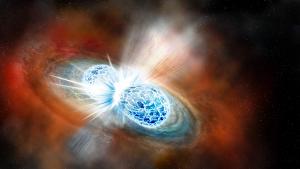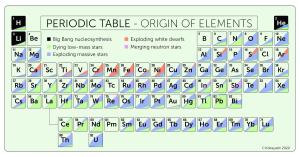Blog
Gold Rush
17 September 2020
 Robin Dienel/Carnegie Institution for Science
Robin Dienel/Carnegie Institution for ScienceIn the beginning, the universe created three elements: hydrogen, helium, and lithium. There isn’t much you can do with these simple elements, other than to let gravity collapse them into stars, galaxies, and black holes. But stars have the power of alchemy. Within their hearts, they can fuse these elements into new ones. Carbon, nitrogen, oxygen, and others, all up to the heavy element of iron. When these first stars exploded, they scattered the new elements across the cosmos, creating planets, new stars, and even us.
It is a profound thought to realize that we are the children of stars. But that view is also overly simplistic. Only the most massive stars explode as brilliant supernovae, and much of the heavier elements created in the explosion will not be scattered. Only half of the carbon we see comes from supernovae. The other half comes from lower-mass stars that expand to red giants as they die. Much of the iron we see comes from Type Ia supernovae, not the more common core-collapse type.
Then there is the origin of the elements heavier than iron. In the standard fusion cycles of stars, members of the periodic table beyond iron can’t be produced, since creating them robs the star of energy rather than giving energy back. It has long been thought that these heavier elements, such as silver and gold, are created when two dense neutron stars collide. The gold of your wedding ring formed in the merging of two stars into one.
 Chiaki Kobayashi et al, Artwork: Sahm Keily
Chiaki Kobayashi et al, Artwork: Sahm KeilyWhile the cosmic tale of the elements is mostly accurate, a new study finds there are still plenty of mysteries in the details.1 In this work, the team looked at the various ways every stable element from carbon to uranium can be produced in the galaxy. They derived an evolutionary chain, calculating each element’s theoretical abundance, and then compared their model to observed abundances in our galaxy.
Their model worked particularly well for the elements through iron, but they found that our standard assumptions can’t account for the heavier elements. In particular, given the past and current rate of neutron star collisions, the amount of heavy elements they can produce is lower than what we observe. Much of the heavy elements must be formed in rare supernovae that occur when a rapidly spinning star generates a strong magnetic field as it collapses. In general, they found that all elements are produced in multiple ways. There is no one astrophysical process through which carbon is made, or iron, or uranium.
The study also raised a mystery about the origin of gold. Their model can account for most of the abundances, but their model can’t account for the amount of gold we see in the galaxy. Merging neutron stars do produce gold, but there must also be some other process we don’t yet understand.
Throughout history, gold has been seen as an almost magical material, malleable, easily forged, and with an eternal luster. This treasured metal could also hold the secret to the alchemy of the cosmos.
Chiaki Kobayashi, et al. “The Origin of Elements from Carbon to Uranium.” The Astrophysical Journal 900.2 (2020): 179 ↩︎